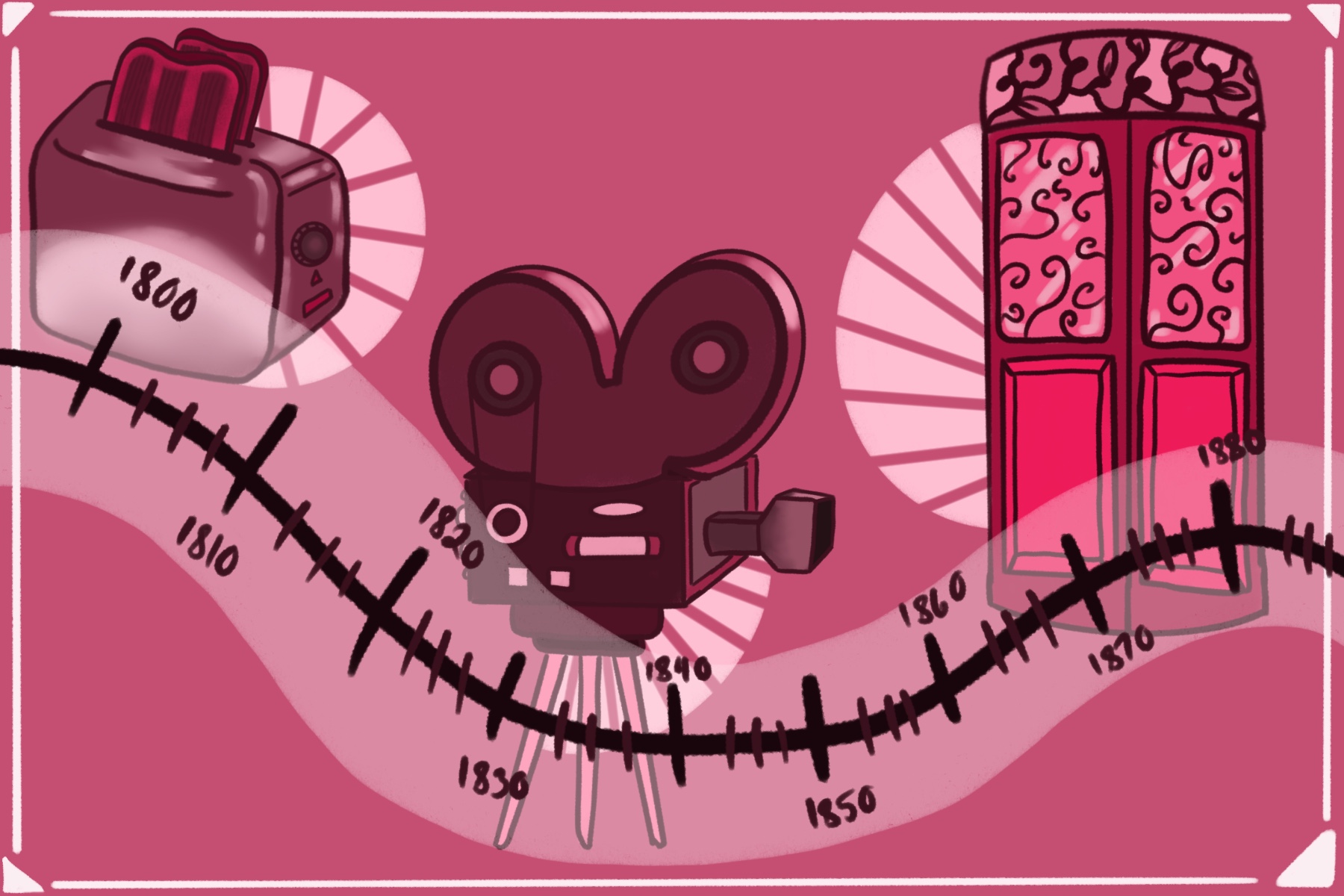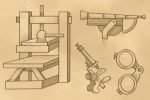Less than 100 years ago, sliced bread hit the shelves. It was the year 1928 when the first sliced bread advertisements called the product “the greatest forward step in the baking industry since bread was wrapped.” Now, it is common to call any new, impressive invention “the greatest thing since sliced bread.” But what were the greatest things before sliced bread? It might come as a surprise that some of our most frequently-used modern luxuries can have their origins traced back to a time before sliced bread was on the market. These luxuries range from the elevator to the motion picture camera and the toaster.
-
The Modern Elevator – 1853
Long before the first electric passenger elevators were in operation, man-powered hoisting devices had been used since the 3rd century. Ancient Greek mathematician, Archimedes, is credited with inventing the first elevator-like device. In the early 19th century, hoisting devices began to rely on steam or water power rather than human strength. But elevator technology wasn’t fit for transporting people until Elisha Graves Otis invented an important safety mechanism in 1852. Otis’ safety brake ensured that the elevator would stay suspended even if the hoisting ropes were to break. Otis proudly revealed his first passenger elevator at New York’s Crystal Palace Convention in 1853. He went on to ensure his elevators were safe, though the public was not instantly ready to trust this new mode of transportation. In 1857, a department store in New York took a leap of faith and had one of Otis’ elevators installed in their five-story building. However, the elevator was shut down only a few years later after customers refused to use it.
In 1861, Elisha Otis passed away. His company was inherited by his sons, Charles Otis and Norton Otis, the latter of whom became a U.S. Congressman. In 1898, the company’s name changed from Otis Brothers & Company to Otis Elevator Company. By this time, the company had begun producing escalators as well. The company is still in operation today, celebrating 170 years since the first elevator with Otis’ safety brake was ever sold. “We move 2 billion people a day,” is what the company boasts. Though it took some time, the elevator has become a trusted mode of transportation and a part of daily life for so many people all around the world.
In many ways, the elevator opened up new possibilities for the modern world. Without the elevator, skyscrapers could not exist. The iconic 102-story Empire State Building needs elevators to allow easy travel up long distances. Climbing the stairs from the first floor to the 100th floor would take far too much time and effort. Consequently, tall buildings have allowed more people to live and work in the same area at once. This is especially helpful in places where land is expensive. Business owners can make the most out of small plots of land by building upwards. But perhaps the most important impact of the elevator is its contribution to accessibility. The addition of the elevator allows the upper floors of buildings to be accessible to people with physical disabilities and impaired mobility. In these ways, the elevator shaped the modern world and made steps towards allowing everyone a fair chance to participate in it.
-
The Motion Picture Camera – 1890
Most widely known as the man behind the light bulb, Thomas Edison was also one of the men behind the motion picture camera. With the help of his assistant, William K. L. Dickson, Edison put together a device he called the kinetograph in 1890. The kinetograph was remarkable for its recording speed when compared to its predecessors. French scientist Etienne-Jules Marey, previously designed a camera that was able to record 12 pictures per second while the kinetograph was able to record 40 images per second. The inventors of the kinetograph achieved this by using a gear-like wheel called a sprocket. This feature allowed a reel of film to move quickly through the camera as the device recorded a series of images.
To allow the recordings of his kinetographs to be seen, Edison also invented a viewing device called the kinetoscope. Viewers would look through a small peephole to see their images on film as they passed between a lens and light bulb. Taking motion-picture viewing to the next level, kinetoscope parlors began opening up. The first of these parlors housed five kinetoscopes and charged customers 25 cents for viewing. Only one person could use a kinetoscope at a time. While there wasn’t popcorn at the movies yet, it might’ve been the first step towards the cinema experience.
One of the first motion pictures ever recorded with the kinetograph is known as “Fred Ott’s Sneeze.” Recorded in 1894, the early recording depicts Edison’s friend and employee Fred Ott sneezing after breathing in a whiff of tobacco. The video is only about five seconds long. As motion picture cameras continued to be manufactured and popularized, longer recordings of daily life in the late 1890s and early 1900s were able to be produced. Many of these videos have been preserved and posted online, providing fascinating views into the bustling streets of busy cities and the faces of the long-gone people who walked them.
The contributions of Edison’s invention are seen in the modern world too. The kinetograph served as a great step towards the motion picture cameras of today. The invention inspired later brilliant minds to improve on what the kinetograph started and make their own innovations. Today, film is a multi-billion dollar industry. Because of the motion picture camera, pop culture and entertainment have been shaped by films, both old favorites and new ones.
-
The Toaster – 1909
Almost two decades before sliced bread was seen on store shelves, General Electric debuted the world’s first commercially successful electric toaster. This toaster was created after years of attempts and failures by many parties to perfect a suitable heating element for the purpose of bread-toasting. In 1905, the necessary heating element was finally crafted. A metallurgist named Albert L. Marsh put together a new type of metal wire called nichrome by combining nickel and chromium. The benefit of this wire produced heat and reheated repeatedly without damage. It was General Electric’s Frank Shailor who managed to put nichrome to use in the early toaster.
Though the first successful electric toaster was available in 1909, it was a long time before toasters became common household items. Even by 1925, electricity was only possessed by about half of American households. Until electricity became more widespread, toasters were only seen in restaurants. The 1909 General Electric toaster hardly looks anything like the toasters of today. The device looked more like a cage with an exposed heating element. Only one side of the bread could be toasted at once and users were required to both manually flip and release the bread from the cage when it appeared to be ready.
In 1919, early toasters began to work more like modern toasters when Charles Strite invented a version with a pop-up mechanism. Strite worked with the Waters-Genter Company to mass produce his “Toastmasters,” which were initially sold only to restaurants, cafes and hotels in the early 1920s. The Toastmasters were finally marketed and sold to homeowners in 1926. As one of the greatest inventions before sliced bread, the toaster quickly became sliced bread’s best friend. Already in households two years before packaged sliced bread was for sale, perhaps the toaster is one of the factors that made sliced bread so great.
Today, toasters go beyond just bread. Huge brands such as Eggo and Pillsbury have launched frozen food products that are made to be compatible with toasters. Eggo’s frozen waffles are one example. Pillbury’s toaster strudels are another example of a food designed for toasters that features the word “toaster” in its name. At the time of its release in 1985, the toaster strudel was praised as a “high-tech” food for its innate compatibility with the toaster. It became one of Pillsbury’s most successful new products that year. Today, it remains one of the company’s most successful products.
Tracing the legacy of these three old inventions, it is clear that they each contributed more to the world than just their originally intended purpose. The elevator gave us our modern city skylines and allowed businesses to accommodate massive amounts of employees in single buildings. The motion picture camera laid the foundation for a multi-billion dollar entertainment industry. The toaster encouraged a host of new food products to be designed and marketed. The inventors of the elevator, the motion picture camera and the toaster cleared the path for more innovators. This includes the creative architects, filmmakers and business people who make use of what their predecessors started. World-changing achievements must start somewhere. Sometimes, they start where you least expect them.















